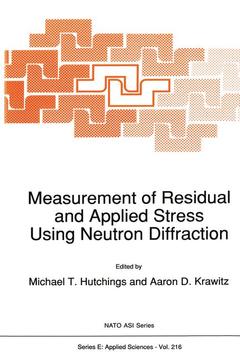Description
Measurement of Residual and Applied Stress Using Neutron Diffraction, Softcover reprint of the original 1st ed. 1992
NATO Science Series E: Series, Vol. 216
Coordinators: Hutchings M.T., Krawitz Aaron D.
Language: English
Keywords
Publication date: 11-2012
588 p. · 16x24 cm · Paperback
588 p. · 16x24 cm · Paperback
Description
/li>Contents
/li>
The accurate, absolute, and non-destructive measurement of residual stress fields within metallic, ceramic, and composite engineering components has been one of the major problems facing engineers for many years, and so the extension of X-ray methods to the use of neutrons represents a major advance. The technique utilizes the unique penetrating power of the neutron into most engineering materials, combined with the sensitivity of diffraction, to measure the separation of lattice planes within grains of polycrystalline engineering materials, thus providing an internal strain gauge. The strain is then converted to stress using calibrated elastic constants. It was just over ten years ago that the initial neutron diffraction measurements of residual stress were carried out, and during the ensuing decade measurements have commenced at most steady state reactors and pulsed sources around the world. So swift has been the development of the field that, in addition to fundamental scientific studies, commercial measurements have been made on industrial components for several years now. The use of neutrons is ideally suited to the determination of triaxial macrostress tensors, macrostress gradients, and microstresses in composites and multiphase alloys as well as deformed, plastically anisotropic metals and alloys. To date, it has been used to investigate welded and heat-treated industrial components, to characterize composites, to study the response of material under applied loads, to calibrate more portable methods such as ultrasonics, and to verify computer modelling calculations of residual and applied stress.
Workshop Papers.- 1. Overview.- ‘Neutron Diffraction Measurement of Residual Stress Fields: Overview and Points for Discussion’.- 2. Background.- ‘Role of Neutron Diffraction in Engineering Stress Analysis’.- ‘Applications of X-ray Residual Stress Measurements in Industrial R&D’.- ‘The Theory of Stress/Strain Analysis with Diffraction’.- ‘The Calculation of Residual Stress’.- ‘Comparison Between Finite Element Calculations and Neutron Diffraction Measurements of Residual Stress in a Diametrically Compressed Ring’.- 3. Aspects of Fundamental Principles.- ‘Macrostresses, Microstresses and Stress Tensors’.- ‘Separation of Microstresses and Macrostresses’.- ‘The Effects of Crystalline Anisotropy on the Elastic Response of Materials’.- ‘Investigation of Large Grained Samples - Principles’.- ‘The Plastic Regime, Including Anisotropy Effects’.- ‘Grain Interaction Stresses’.- ‘Relaxation’.- ‘Interpretation of Residual Stress Measurements: Summary of Discussion Session’.- 4. Aspects of Experimental Measurement.- ‘Spatial Resolution and Strain Scanning’.- ‘Strain Tensor Measurements by Neutron Diffraction’.- ‘Investigations of Large Grained Samples - Examples’.- ‘The Stress-free Reference Sample: Alloy Composition Information from Neutron Capture’.- ‘The Precision of Peak Position Determination in Diffraction Measurements of Stress’.- ‘Errors in Analysis’.- 5. Instrumentation.- 5a Instrumentation: Steady State Reactor.- ‘Optimised Geometry for a Stress Measurement Two-axis Diffractometer at a Reactor’.- ‘Implementation and Application of a Psd Set-Up for Neutron Diffraction Strain Measurements’.- ‘Reverse Time-of-Flight Fourier Technique for Strain Measurements’.- ‘The Alignment ofInstrumentation and the Positioning of Specimens for Stress Measurements by Means of Neutron Diffraction’+.- ‘Proposal for a Neutron Strain Measurement Apparatus’+.- ‘Microbeam Techniques in Diffraction: A Theoretical Treatment’.- ‘Summary of the Panel Discussion on Instrumentation at Steady State Sources’.- 5b Instrumentation; Pulsed Neutron Source.- ‘Residual and Applied Stress Measurements at Ipns’.- ‘Residual Stress Measurement Using the Pulsed Neutron Source at Lansce’.- ‘Stress Measurement: Experience at Isis’.- ‘Transmission Bragg-Edge Measurements’.- ‘Macs, The Manipulation and Collimation System on the NPD at Lansce’+.- ‘The Design of a Pulsed Source Instrument: Summary of Discussion Session’.- 6. Composites.- ‘Stress Measurements in Composites Using Neutron Diffraction’.- ‘Theory and Modelling of Composites’.- ‘Application of Neutron Diffraction Time-of-Flight Measurements to the Study of Strain in Composites’.- ‘Deformation Analysis in Mixed Composites’.- ‘Surface and Near-surface Analysis of Residual Stresses in Aluminium and Titanium Alloys - Examples of the Case for X-ray Diffraction’.- ‘Residual Stresses in Brazed Ceramic-metal Compounds’.- 7. Measurements on Bulk Components.- ‘Residual Stress Distribution in Cracked Autofrettaged Tubing’.- ‘Measurement of Stresses in Metal Adhesive Joints’.- ‘Residual Stress Measurements in Armament-related Components’.- ‘Problems with Railway Rails’+.- ‘Neutron Measurements of Residual Strain in Some Technological Materials and Components’+.- ‘Development of the Neutron Diffraction Technique for the Determination of Near Surface Residual Stresses in Critical Gas Turbine Components’+.- ‘Residual Stresses at Cold Expanded FastenerHoles’+.- ‘Neutron and X-ray Diffraction Residual Stress Measurements on Power Generator Turbine Blades: Comparison with Finite Element Analysis’.- 8. Comparison of Neutrons with X-Rays and Other Stress Probes.- ‘Calibration of Portable NDE Techniques for Residual Stress Measurement’.- ‘Triaxial Analysis of Residual Stress Fields in Metallic Plates’+.- ‘Pitfalls of Layer Removal Techniques in X-ray Residual Stress Measurements’.- ‘Neutrons Versus X-rays’.
© 2024 LAVOISIER S.A.S.




